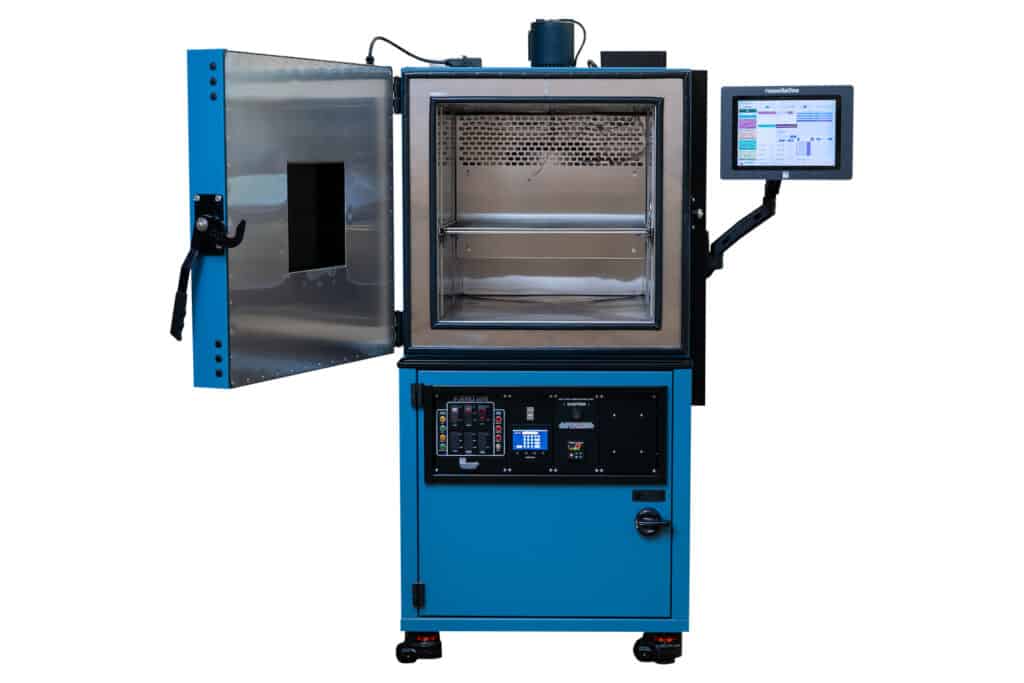Thermal analysis is a critical component in understanding how products respond to extreme environments and provides engineering insights into product longevity and reliability. For example, thermal testing for electrical vehicle (EV) batteries is critical for their qualification and validation. Thermal test chambers bring real-world environmental conditions into the laboratory space, allowing for the safe and effective exposure of products to variable temperature conditions. Exploring some of the industry uses and applications will help you assess if a thermal chamber is appropriate for your testing requirements.
What is Temperature Testing? Understanding Thermal Test Chambers
Thermal test chambers (or temperature test chambers) are widely used in a variety of industries and applications. Common uses include steady-state or stability testing, thermal cycling or thermal shock, and other applications for today’s testing needs. Key industry requirements define specific testing protocols and standards which are frequently updated to keep pace with the dramatically accelerating advancements in consumer technologies. Several key industries and applications include:
EV Batteries
With the increasing demand for vehicle electrification, OEMs, suppliers and manufacturers must keep pace with the changing technologies and regulatory environment. While a variety of methods and specifications exist, several key applications for EV battery test chambers include thermal cycling and thermal shock, reliability, and robustness from vibration, overcharge and discharge protection, and over-temperature protection. Thermal chambers are especially useful for simulating cold start conditions where various temperature extremes need to be verified. Several common standards for vehicle battery certification include UL 1642 (lithium cells), IEC 62660, ISO 12405, SAE J1772, and IEEE 1725.
Aerospace and Defense
Various space and defense programs rely on ground testing to ensure the proper and successful operation of components, systems, payloads, sensors, and more. Thermal shock chambers allow for thermal cycling of components to simulate the harsh environments experienced at altitude, while thermal vacuum chambers allow space components and subsystems to endure both extreme temperature and deep vacuum. Commercial, military, and aerospace industries require exact thermal temperature tolerances as defined by industry standards including MIL-STD-1540, MIL-STD-750, EIA-364-32, and more.
Electronics
Thermal testing and cycling of electronics and components is generally accomplished by exposing parts to temperatures exceeding normal operating temperature to detect for defects including solder joint and hermetic seal failure, as well as lead and marking damage. Thermal induced stress on electronics and components also helps to identify changes to the physical characteristics of components which could lessen the reliability and lifespan of those products. In other cases, thermal testing is used to produce component validation where wider temperature ranges exceeding normal operation are used to identify the maximum and minimum operating temperature for those components. Various industry standards exist, though the widely accepted eleven standards that comprise JDEC 51 specifically address thermal measurement of component packages in various environmental conditions.
Other Industries
There are extensive industries and services which develop products that must comply with national and international standards using forms of thermal testing. Some industries and standardization bodies include building and construction materials (ASTM, ANSI, ISO), chemicals, energy commodities, consumer products, and healthcare including pharmaceutical and medical devices.
What are the Most Important Considerations for Thermal Chambers?
While the industries and uses of thermal chambers are nearly limitless, it is important to define a few key parameters when sourcing a thermal chamber for your testing requirements.
Performance
In order to secure the right thermal chamber, it is critical to define key performance parameters including the desired temperature range, temperature and product required change rates, and your complete test profile. Will your testing incorporate humidity as well as temperature? If so, how will this impact your product and test specification? How often will you be testing? Understanding the duration and frequency of your thermal testing will help to better define the parameters of your desired thermal chamber.
Size
Knowing the size, material composition, fixture requirements, and total mass to be tested at one time will help define the dimensions of the thermal chamber for your requirements. Benchtop and reach-in thermal chambers are designed to maximize space and efficiency in your lab, formatted with the standard performance of larger chambers, but with a condensed footprint. Larger devices under test (DUT) may require loading via a cart, pallet jack, or forklift, which generally requires a walk-in chamber to meet your specifications. Understanding your lab or facility floor space, utilities, and infrastructure is critical to ensuring the right system is selected and installed.
Timeline
Once you have defined your performance and sizing requirements, you will want to understand the timeline and budget considerations that could impact your testing plans. Most reach-in and smaller thermal chambers are offered from various manufacturers at reduced lead times, sometimes even in stock and ready to ship. As such, these chambers are more economical than their comparable walk-in and drive-in alternatives. Lead times vary across the industry, but a general principle to apply is to give yourself a year timeline to plan, search, purchase, receive, install, and validate a walk-in or drive-in thermal chamber.
At Russells Technical Products, we go beyond providing environmental test chambers. We’re a total partner in the industry, offering one-on-one support throughout your process, from acquisition to installation. Our primary goal is to develop a relationship based on trust and confidence so you can deliver on your objectives. Contact us today to get started.
